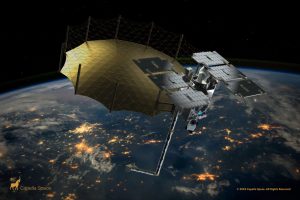The space mission – dubbed WindCube – will involve the first wind measuring interferometer to be carried on a small 6-U LEO CubeSat, with XCAM providing an advanced imaging camera system.
The Northampton-based company designs and manufactures highly specialised complex digital camera systems – for example, bespoke imaging sensors – for challenging scientific applications, including space. It says this latest mission will help scientists to improve models of the upper atmosphere and help better predict impacts to communication systems and satellites.
WindCube
 The scientific payload of WindCube is a limb-viewing Fabry Perot interferometer for thermospheric wind observation using Doppler shift measurements of the 630.0nm oxygen emission line. It aims to address a key science goal in the NASA Decadal survey.
The scientific payload of WindCube is a limb-viewing Fabry Perot interferometer for thermospheric wind observation using Doppler shift measurements of the 630.0nm oxygen emission line. It aims to address a key science goal in the NASA Decadal survey.
XCAM’s camera will be integrated with the interferometry technology. The heart of the camera system is XCAM’s new ‘Nuscis’ SmallSat and CubeSat-compatible space imager. This has been enhanced, for WindCube, to enable the imager to use a sensitive Electron Multiplying CCD sensor and control the temperature the sensor operates at.
“The WindCube mission will generate global maps of thermospheric winds by measuring the Doppler shifts of visible light emitted by atomic oxygen within a CubeSat form factor,” said Scott Sewell, Engineering Group Manager at UCAR’s High Altitude Observatory (HAO) and Principle Investigator (PI) of the WindCube mission.
“In order to measure the very weak signals produced by the payload’s Fabry-Perot imager, the camera system is a critical element.”
The WindCube mission, due to launch in 2024, and operate for around 12 months. It is part of one of the NASA funded H-FORT (Heliophysics Flight Opportunities for Research and Technology) missions.
UCAR is a non-profit consortium of 122 North American colleges and universities focused on research and training in Earth system science. UCAR manages the National Center for Atmospheric Research (NCAR) on behalf of the National Science Foundation.
Particle contamination
In March, we reported the European Space Agency was funding the manufacture of XCAM’s particle contamination monitor for space flight, which was described as a world’s first.
It followed an 8-year technical development programme in collaboration with the agency supporting the manufacture of its Space Particle Fall Out (PFO) Monitor. This is due to launch into space inside a rocket launch vehicle fairing in the summer of 2025.
It will be the first instrument to measure particulate contamination inside a fairing during, and shortly after launch, highlighted XCAM. It is believed that contamination can seriously affect the accuracy and reliability of the multi-million dollar instruments which are sent into space, whether to study Earth or explore the universe.
Image: Design concept incorporating XCAM – a multi-sensor camera system using two stacked Nuscis ICBs.
See also: Nottingham University funds UK firms tackling space environmental impact
 Electronics Weekly Electronics Design & Components Tech News
Electronics Weekly Electronics Design & Components Tech News




